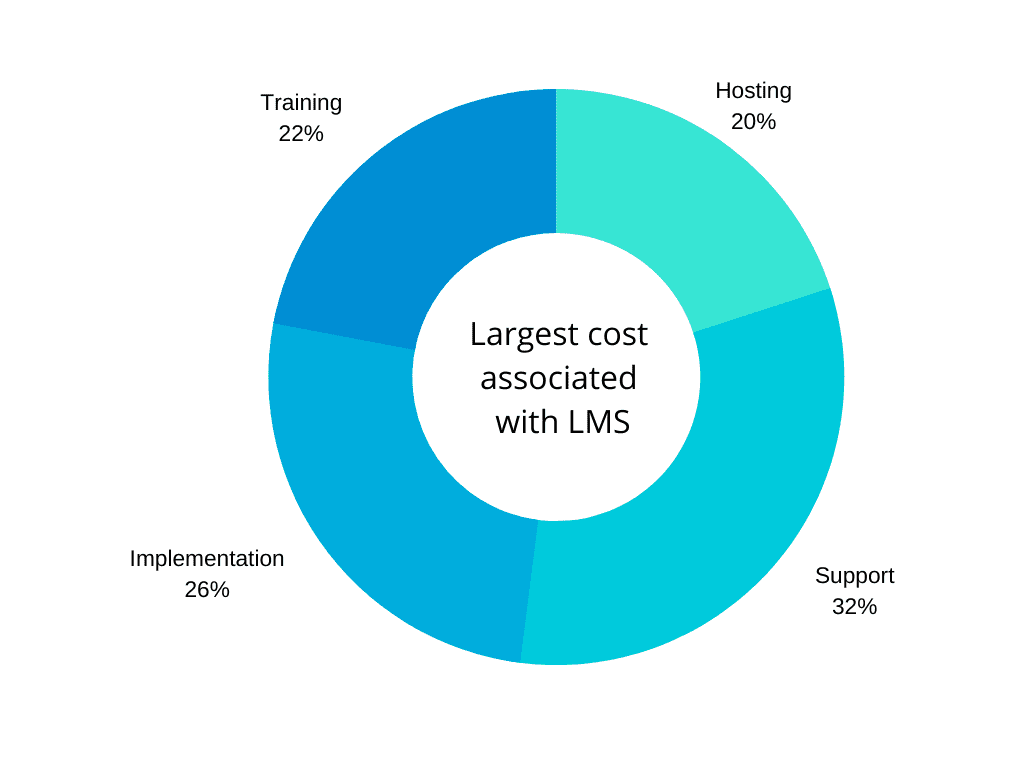The e-learning industry as of now is a $200-billion marketplace and there is no stopping to it. Businesses and organizations are continuously and heavily investing in e-learning solutions and learning management systems (LMS) for the skill development of their staff and employees. This in turn gives them a competitive edge and helps drive higher revenues and growth.
However, as the organizations invest in the implementation and use of LMS, a major issue comes with the costs of these solutions. Organizations want LMS with features that can cater to their business needs in entirety, but with those features how the costs are allocated is an important consideration. It is only with the proper allocation of the costs that organizations will be able to get the most value from their LMS and attain higher ROI.
However, before you can know the allocation of these costs, you need to know what makes up for them. The graph below shows what percentage of your LMS investments are spent in what areas of its use.

The above graph makes it clear that the major costs are spent on the implementation of LMS software which is further followed by costs on training, hosting, and support.
While these costs are a part of your LMS project, they must not be hefty, else the entire purpose for making investments in such solutions shall fail. What you need is a proper plan devised for the cost management of your Learning Management System.
So, the big question is how do you optimize your LMS costs? Well, let us talk and phase them out one by one.
Optimizing LMS Costs
Implementation Costs
The highest costs associated with any Learning Management System project comes from the very implementation of it. It is a big decision to implement an LMS and the confusion comes when you are to make a choice between a proprietary LMS and Open Source LMS.
It is very important to get this choice right. Most often, organizations face issues with scalability and system integration of their LMS. So as to not face this challenge, open-source LMS is preferred over the proprietary ones. They are also good for keeping the costs managed and optimized.
Open Source LMS allows us to change, modify, and redistribute the source code freely, have an easy interface, and can be implemented at minimal expenses. Moreover, they have unlimited ability to scale and you can easily add up to their features and functionalities. So, as your organization grows and requirements for additional features and functionalities begin to cloud, open-source LMS implementation will come extremely handy and beneficial to you in terms of flexibility as well as costs.
Training Costs
The costs associated with training are real and they can go beyond your expected investments and expenditures if not managed well. The need is to have LMS which is easily understandable and readily usable. The more quickly your employees and staff cope with the LMS system, the easier the training becomes for them which in turn results in reduced and optimized training costs for LMS software.
To make such easy, simple, and user-friendly LMS, you need to look into your organizational needs and analyze them thoroughly. Additionally, your choice of platform for LMS will leave a big impact. Using platforms like LearnDash can be very beneficial since it helps create a highly functional and feature-rich learning management system with customized themes and designs that cater to excellent user appeal and experiences.
Hosting and Support
After you have LMS software implemented, you need hosting and support for it which again comes as a big expenditure. However, it can be optimized by making an intelligible choice between self-hosting and cloud-hosting.
Self-hosting will involve you managing the LMS software internally and depending on the technical expertise required for that, it can come as a costly affair. Contrary to this, the LMS is managed and hosted externally by professionals when you opt for cloud hosting. This is a much more cost-effective option since it significantly brings down the costs with zero needs on part of the organization to manage the LMS. The organization can simply keep leveraging the learning management system for higher revenues.
Additionally, you also get support with cloud-hosting which significantly brings down the support costs for your organization.
A place for big ideas.
Reimagine organizational performance while delivering a delightful experience through optimized operations.

Conclusion
This was all about the costs associated with Learning Management Systems and ways to manage and optimize them. E-learning solutions and LMS software give a significant competitive edge to your organization and you can create better brand positioning with higher productivity and a more skilled workforce. They will also help increase revenues. However, all this shall work positively only when the costs are managed well and kept at an optimum level. You need to go a little extra mile for that, but they are easy solutions. So, implement the necessary solutions and manage your LMS costs.












